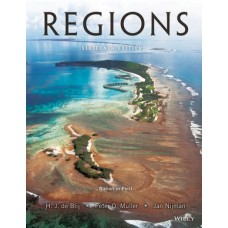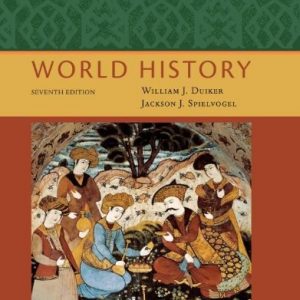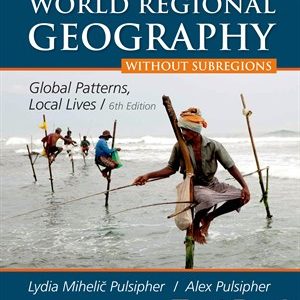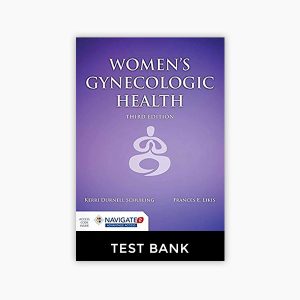Instant download Test Bank for Geography: Realms, Regions, and Concepts, 16th Edition by de Blij, Muller, Nijman pdf docx epub after payment.

Chapter Number: 01
Question Type: Multiple Choice
01) What is true about the geography of the North European Lowland?
- a) It contains the mountain ranges of the Alps.
- b) It is the most densely populated of Europe’s landscape regions.
- c) It does not include southeastern England.
- d) It has historically functioned as a barrier to contact and communication due to its marshy conditions.
Answer: b
Difficulty: Easy
Learning Objective 1: 1A.1 Describe Europe’s geographic limits, environmental foundations, resource opportunities, and locational advantages.
Section Reference 1: Geographical Features
Bloomcode: Comprehension
02) What term represents the geographic principle under which particular peoples and particular places concentrate on the production of particular goods?
- a) complementarity
- b) Balkanization
- c) supranationalism
- d) local functional specialization
Answer: d
Difficulty: Easy
Learning Objective 4: 1A.4 Discuss the evolution of modern Europe in spatial context and its impact on the world.
Section Reference 4: Modern Historical Geography
Bloomcode: Knowledge
03) Which of the following is true of the Industrial Revolution in Europe?
- a) It produced the first specialized industries anywhere in the realm.
- b) It triggered a large immigration of workers from other parts of the world to fill the available jobs in the factories.
- c) It was initially focused in England, where machinery was invented and the use of steam to power engines emerged.
- d) It gave enormous situational advantage to large cities such as London and Paris, both positioned on coalfields and near iron ores.
Answer: c
Difficulty: Easy
Learning Objective 4: 1A.4 Discuss the evolution of modern Europe in spatial context and its impact on the world.
Section Reference 4: Modern Historical Geography
Bloomcode: Comprehension
04) Which of the following is true of Europe’s political revolution?
- a) It began in 1789 with the French Revolution.
- b) It ended with the division of the German state in 1945.
- c) It was stimulated by the new weaponry produced by the Industrial Revolution.
- d) It originated as a reaction to the oppression of the Roman Empire.
Answer: a
Difficulty: Easy
Learning Objective 4: 1A.4 Discuss the evolution of modern Europe in spatial context and its impact on the world.
Section Reference 4: Modern Historical Geography
Bloomcode: Comprehension
05) What forces are divisive to a nation?
- a) situational
- b) centripetal
- c) centrifugal
- d) charismatic
Answer: c
Difficulty: Easy
Learning Objective 7: 1A.7 Demonstrate the rise of European unification in terms of the economic, political, and cultural issues that drive this process.
Section Reference 7: European Unification
Bloomcode: Knowledge
06) What term represents a country’s leading urban center that is disproportionately large and exceptionally expressive of national feelings?
- a) core city
- b) primate city
- c) entrepôt
- d) functional region
Answer: b
Difficulty: Easy
Learning Objective 5: 1A.5 Describe the forces that are shaping 21st century Europe and its changing population.
Section Reference 5: Contemporary Europe: A Dynamic Realm
Bloomcode: Knowledge
07) Which of the following is not an example of European supranationalism?
- a) Benelux
- b) the Euro currency
- c) the European Union
- d) Ukraine’s Orange Revolution
Answer: d
Difficulty: Medium
Learning Objective 7: 1A.7 Demonstrate the rise of European unification in terms of the economic, political, and cultural issues that drive this process.
Section Reference 7: European Unification
Bloomcode: Application
08) Only the southern portion of what island was recently granted admission to the EU?
- a) Ireland
- b) Malta
- c) Turkey
- d) Cyprus
Answer: d
Difficulty: Medium
Learning Objective 5: 1A.5 Describe the forces that are shaping 21st century Europe and its changing population.
Section Reference 5: Contemporary Europe: A Dynamic Realm
Bloomcode: Application
09) Which of the following is the process whereby regions within a state demand political strength and autonomy?
- a) devolution
- b) irredentism
- c) complementarity
- d) supranationalism
Answer: a
Difficulty: Easy
Learning Objective 8: 1A.8 Analyze the impact of the EU on its member nations in terms of economics, politics and the citizens of those member nations.
Section Reference 8: Consequences of Unification
Bloomcode: Knowledge
10) Which of the following cities is not part of one of the Four Motors of Europe?
- a) Brussels
- b) Milan
- c) Stuttgart
- d) Barcelona
Answer: a
Difficulty: Easy
Learning Objective 8: 1A.8 Analyze the impact of the EU on its member nations in terms of economics, politics and the citizens of those member nations.
Section Reference 8: Consequences of Unification
Bloomcode: Comprehension
11) Which of the following religions has gradually lost adherents since secularization gathered momentum in the late 1960s, especially in western Europe?
- a) Islam
- b) Hinduism
- c) Judaism
- d) Christianity
Answer: d
Difficulty: Easy
Learning Objective 5: 1A.5 Describe the forces that are shaping 21st century Europe and its changing population.
Section Reference 5: Contemporary Europe: A Dynamic Realm
Bloomcode: Comprehension
12) Which of the following countries has been pulling through the global recession better than any other country in the European realm?
- a) France
- b) Italy
- c) the United Kingdom
- d) Germany
Answer: d
Difficulty: Easy
Learning Objective 2: 1B.2 Discuss the concept of the “European core” in western Europe and analyze the present and future role of the core countries in the unification of Europe.
Section Reference 2: The Mainland Core
Bloomcode: Comprehension
13) What is the name of the major river in western Germany that enters the North Sea through the Netherlands and passes through the Ruhr?
- a) Rhône
- b) Danube
- c) Elbe
- d) Rhine
Answer: d
Difficulty: Easy
Learning Objective 2: 1B.2 Discuss the concept of the “European core” in western Europe and analyze the present and future role of the core countries in the unification of Europe.
Section Reference 2: The Mainland Core
Bloomcode: Knowledge
14) Which of the following statements is correct about German reunification?
- a) It occurred in 1990.
- b) It has resulted in economic equalization between former East and West Germany.
- c) It has led to a country with eight Autonomous Communities.
- d) It took place immediately after the end of World War II.
Answer: a
Difficulty: Easy
Learning Objective 2: 1B.2 Discuss the concept of the “European core” in western Europe and analyze the present and future role of the core countries in the unification of Europe.
Section Reference 2: The Mainland Core
Bloomcode: Comprehension
15) What is the only European country that has a coastline on the Atlantic Ocean, Mediterranean Sea, and the North Sea?
- a) Portugal
- b) Germany
- c) Spain
- d) France
Answer: d
Difficulty: Easy
Learning Objective 2: 1B.2 Discuss the concept of the “European core” in western Europe and analyze the present and future role of the core countries in the unification of Europe.
Section Reference 2: The Mainland Core
Bloomcode: Comprehension
16) Which of the following statements comparing Germany and France is false?
- a) Germany is larger territorially than France.
- b) Germany has a better river system than France.
- c) Germany is more industrialized than France
- d) Germany has better harbors than France.
Answer: d
Difficulty: Easy
Learning Objective 2: 1B.2 Discuss the concept of the “European core” in western Europe and analyze the present and future role of the core countries in the unification of Europe.
Section Reference 2: The Mainland Core
Bloomcode: Comprehension
17) Which of the following statements regarding the site and situation of Paris is true?
- a) Paris initially benefited from an excellent site.
- b) Paris initially benefited from an excellent situation.
- c) The site of Paris is far inferior to that of any other French city.
- d) Paris initially benefitted from both excellent site and situation.
Answer: d
Difficulty: Easy
Learning Objective 2: 1B.2 Discuss the concept of the “European core” in western Europe and analyze the present and future role of the core countries in the unification of Europe.
Section Reference 2: The Mainland Core
Bloomcode: Comprehension
18) Where are the administrative headquarters of the European Union located?
- a) Geneva
- b) Paris
- c) Brussels
- d) Strasbourg
Answer: c
Difficulty: Easy
Learning Objective 2: 1B.2 Discuss the concept of the “European core” in western Europe and analyze the present and future role of the core countries in the unification of Europe.
Section Reference 2: The Mainland Core
Bloomcode: Knowledge
19) Which of the following cities is located in the Randstad conurbation?
- a) Berlin
- b) Amsterdam
- c) Copenhagen
- d) Vienna
Answer: b
Difficulty: Easy
Learning Objective 2: 1B.2 Discuss the concept of the “European core” in western Europe and analyze the present and future role of the core countries in the unification of Europe.
Section Reference 2: The Mainland Core
Bloomcode: Knowledge
20) Which of the following western European states is not a member of the European Union?
- a) Austria
- b) Luxembourg
- c) the Netherlands
- d) Switzerland
Answer: d
Difficulty: Easy
Learning Objective 2: 1B.2 Discuss the concept of the “European core” in western Europe and analyze the present and future role of the core countries in the unification of Europe.
Section Reference 2: The Mainland Core
Bloomcode: Comprehension
21) Where have significant oil and natural gas supplies been found in the European realm?
- a) Baltic Sea
- b) Gulf of Finland
- c) North Sea
- d) Adriatic Sea
Answer: c
Difficulty: Easy
Learning Objective 3: 1B.3 Compare the differences between the regional components of the British Isles and the reasons behind them.
Section Reference 3: The Core Offshore: The British Isles
Bloomcode: Knowledge
22) The conurbation centered by London lies within which of the following regions?
- a) southern England
- b) northern England
- c) Scotland
- d) Wales
Answer: a
Difficulty: Easy
Learning Objective 3: 1B.3 Compare the differences between the regional components of the British Isles and the reasons behind them.
Section Reference 3: The Core Offshore: The British Isles
Bloomcode: Knowledge
23) The population of Northern Ireland is:
- a) not part of the European Union.
- b) made up of refugees from Wales.
- c) politically dominated by Protestants.
- d) not part of the United Kingdom.
Answer: c
Difficulty: Easy
Learning Objective 3: 1B.3 Compare the differences between the regional components of the British Isles and the reasons behind them.
Section Reference 3: The Core Offshore: The British Isles
Bloomcode: Comprehension
24) Which of the following is the Discontinuous North’s largest country in terms of both population and territory?
- a) Denmark
- b) Sweden
- c) Norway
- d) Finland
Answer: b
Difficulty: Easy
Learning Objective 5: 1B.5 Describe how core-periphery contrasts shape the geography of Europe’s Northern domain.
Section Reference 5: The Discontinuous North
Bloomcode: Knowledge
25) What Northern European country has benefited the most from North Sea oil?
- a) Denmark
- b) Norway
- c) Iceland
- d) Finland
Answer: b
Difficulty: Easy
Learning Objective 5: 1B.5 Describe how core-periphery contrasts shape the geography of Europe’s Northern domain.
Section Reference 5: The Discontinuous North
Bloomcode: Knowledge
26) What country is located on the Jutland Peninsula and is the smallest-sized state in Northern Europe?
- a) Sweden
- b) Norway
- c) Estonia
- d) Denmark
Answer: d
Difficulty: Easy
Learning Objective 5: 1B.5 Describe how core-periphery contrasts shape the geography of Europe’s Northern domain.
Section Reference 5: The Discontinuous North
Bloomcode: Knowledge
27) Which Nordic European city serves as a break of bulk, or entrepôt, city?
- a) Stockholm
- b) Copenhagen
- c) Oslo
- d) Reykjavik
Answer: b
Difficulty: Medium
Learning Objective 5: 1B.5 Describe how core-periphery contrasts shape the geography of Europe’s Northern domain.
Section Reference 5: The Discontinuous North
Bloomcode: Application
28) What country has more in common with Finland than its other neighboring states, and is therefore included as part of Northern Europe?
- a) Estonia
- b) Latvia
- c) Lithuania
- d) Kaliningrad
Answer: a
Difficulty: Easy
Learning Objective 5: 1B.5 Describe how core-periphery contrasts shape the geography of Europe’s Northern domain.
Section Reference 5: The Discontinuous North
Bloomcode: Comprehension
29) The Iberian Peninsula is isolated from the rest of Europe by what mountain range?
- a) Appennines
- b) Alps
- c) Pyrenees
- d) Pennines
Answer: c
Difficulty: Easy
Learning Objective 4: 1B.4 Describe how core-periphery contrasts shape the geography of the Mediterranean Basin and the Western Balkan Peninsula.
Section Reference 4: The Discontinuous South
Bloomcode: Knowledge
30) What is the Mediterranean European country with the lowest percentage of urban residents?
- a) Spain
- b) Portugal
- c) France
- d) Italy
Answer: b
Difficulty: Easy
Learning Objective 4: 1B.4 Describe how core-periphery contrasts shape the geography of the Mediterranean Basin and the Western Balkan Peninsula.
Section Reference 4: The Discontinuous South
Bloomcode: Knowledge
31) Where is Italy’s economic core located today?
- a) Sicily
- b) the Po River Valley
- c) the Naples-Venice conurbation
- d) Catalonia
Answer: b
Difficulty: Easy
Learning Objective 4: 1B.4 Describe how core-periphery contrasts shape the geography of the Mediterranean Basin and the Western Balkan Peninsula.
Section Reference 4: The Discontinuous South
Bloomcode: Comprehension
32) Which of the following cities is located in Italy’s and Europe’s core area?
- a) Milan
- b) Rome
- c) Barcelona
- d) Naples
Answer: a
Difficulty: Easy
Learning Objective 4: 1B.4 Describe how core-periphery contrasts shape the geography of the Mediterranean Basin and the Western Balkan Peninsula.
Section Reference 4: The Discontinuous South
Bloomcode: Knowledge
33) What economically divides Northern and Southern Italy?
- a) Alps
- b) Appennines
- c) Po River
- d) Ancona Line
Answer: d
Difficulty: Easy
Learning Objective 4: 1B.4 Describe how core-periphery contrasts shape the geography of the Mediterranean Basin and the Western Balkan Peninsula.
Section Reference 4: The Discontinuous South
Bloomcode: Knowledge
34) What country is located directly across the Strait of Gibraltar from southernmost Spain?
- a) Portugal
- b) Morocco
- c) Italy
- d) Gibraltar
Answer: b
Difficulty: Easy
Learning Objective 4: 1B.4 Describe how core-periphery contrasts shape the geography of the Mediterranean Basin and the Western Balkan Peninsula.
Section Reference 4: The Discontinuous South
Bloomcode: Knowledge
35) Which of the following is the Autonomous Community located in northeastern Spain just south of the Pyrenees Mountains and is centered on industrialized Barcelona?
- a) Portugal
- b) Andalusia
- c) Catalonia
- d) Gibraltar
Answer: c
Difficulty: Easy
Learning Objective 4: 1B.4 Describe how core-periphery contrasts shape the geography of the Mediterranean Basin and the Western Balkan Peninsula.
Section Reference 4: The Discontinuous South
Bloomcode: Comprehension
36) What territory is Spain and the United Kingdom in a dispute over?
- a) Cyprus
- b) Kosovo
- c) Ceuta
- d) Gibraltar
Answer: d
Difficulty: Easy
Learning Objective 4: 1B.4 Describe how core-periphery contrasts shape the geography of the Mediterranean Basin and the Western Balkan Peninsula.
Section Reference 4: The Discontinuous South
Bloomcode: Knowledge
37) What is the capital and primate city of Greece?
- a) Sparta
- b) Malta
- c) Athens
- d) Cyprus
Answer: c
Difficulty: Easy
Learning Objective 4: 1B.4 Describe how core-periphery contrasts shape the geography of the Mediterranean Basin and the Western Balkan Peninsula.
Section Reference 4: The Discontinuous South
Bloomcode: Knowledge
38) What is the Mediterranean island contested by both Greece and Turkey?
- a) Cyprus
- b) Crete
- c) Malta
- d) Sicily
Answer: a
Difficulty: Easy
Learning Objective 4: 1B.4 Describe how core-periphery contrasts shape the geography of the Mediterranean Basin and the Western Balkan Peninsula.
Section Reference 4: The Discontinuous South
Bloomcode: Knowledge
39) The international community recognizes which government on Cyprus?
- a) Greek Cypriot
- b) Turkish Cypriot
- c) Islamic
- d) Maltese
Answer: a
Difficulty: Easy
Learning Objective: Describe how core-periphery contrasts shape the geography of the Mediterranean Basin and the Western Balkan Peninsula.
Section Reference: The Discontinuous South
Bloomcode: Knowledge
40) What term is used to describe eastern Europe as a zone of politico-geographical splintering and fracturing?
- a) irredentist region
- b) periphery
- c) shatter belt
- d) Balkan conurbation
Answer: c
Difficulty: Easy
Learning Objective 6: 1B.6 Analyze the post-Soviet evolution of states formerly behind the iron curtain and their responses to the challenge of peripheral location.
Section Reference 6: The Eastern Periphery
Bloomcode: Comprehension
41) Which of the following describes the term Balkanization?
- a) a peculiar language that is spoken in Bulgaria
- b) the landmass located west of the Adriatic Sea
- c) the phenomenon of Serbian supranationalism
- d) the division and fragmentation of the southern portion of eastern Europe
Answer: d
Difficulty: Medium
Learning Objective 6: 1B.6 Analyze the post-Soviet evolution of states formerly behind the iron curtain and their responses to the challenge of peripheral location.
Section Reference 6: The Eastern Periphery
Bloomcode: Comprehension
42) The Danube River empties into what sea?
- a) Adriatic
- b) Mediterranean
- c) Aegean
- d) Black
Answer: d
Difficulty: Easy
Learning Objective 6: 1B.6 Analyze the post-Soviet evolution of states formerly behind the iron curtain and their responses to the challenge of peripheral location.
Section Reference 6: The Eastern Periphery
Bloomcode: Knowledge
43) From the end of World War II until 1990, what dominated politics in eastern Europe?
- a) Ottoman Turks
- b) Hapsburg Empire
- c) European Community
- d) Soviet Union
Answer: d
Difficulty: Easy
Learning Objective 6: 1B.6 Analyze the post-Soviet evolution of states formerly behind the iron curtain and their responses to the challenge of peripheral location.
Section Reference 6: The Eastern Periphery
Bloomcode: Comprehension
44) Where is the leading manufacturing/industrial complex in Poland located?
- a) the Bohemian Basin
- b) the Warsaw area
- c) the Vistula Valley
- d) Silesia
Answer: d
Difficulty: Easy
Learning Objective 6: 1B.6 Analyze the post-Soviet evolution of states formerly behind the iron curtain and their responses to the challenge of peripheral location.
Section Reference 6: The Eastern Periphery
Bloomcode: Knowledge
45) Which of the following is the Russian exclave located between Lithuania and Poland?
- a) Kaliningrad
- b) Leningrad
- c) Latvia
- d) Estonia
Answer: a
Difficulty: Easy
Learning Objective 6: 1B.6 Analyze the post-Soviet evolution of states formerly behind the iron curtain and their responses to the challenge of peripheral location.
Section Reference 6: The Eastern Periphery
Bloomcode: Knowledge
46) Which former Soviet Socialist Republic is also called White Russia and is still strongly linked to Moscow?
- a) Belarus
- b) Lithuania
- c) Moldova
- d) Estonia
Answer: a
Difficulty: Easy
Learning Objective 6: 1B.6 Analyze the post-Soviet evolution of states formerly behind the iron curtain and their responses to the challenge of peripheral location.
Section Reference 6: The Eastern Periphery
Bloomcode: Comprehension
47) Which of the following is a significant minority found in Slovakia?
- a) Czech
- b) Hungarian
- c) Serbian
- d) Slovenian
Answer: b
Difficulty: Easy
Learning Objective 6: 1B.6 Analyze the post-Soviet evolution of states formerly behind the iron curtain and their responses to the challenge of peripheral location.
Section Reference 6: The Eastern Periphery
Bloomcode: Knowledge
48) What term represents when a state seeks to acquire the neighboring territory of another country that is home to ethnically similar people?
- a) colonization
- b) devolution
- c) interference
- d) irredentism
Answer: d
Difficulty: Easy
Learning Objective 6: 1B.6 Analyze the post-Soviet evolution of states formerly behind the iron curtain and their responses to the challenge of peripheral location.
Section Reference 6: The Eastern Periphery
Bloomcode: Knowledge





